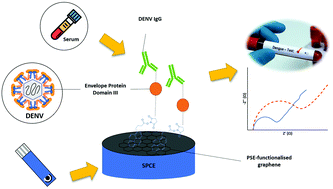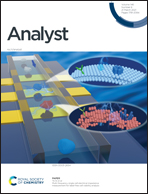A graphene-based dengue immunosensor using plant-derived envelope glycoprotein domain III (EDIII) as the novel probe antigen
Abstract
The envelope glycoprotein domain III (EDIII) of dengue virus (DENV) has been recognised as the antigenic region responsible for receptor binding. In the present work, we have proposed a novel immunosensor constructed on a graphene-coated screen-printed carbon electrode (SPCE) using plant-derived EDIII as the probe antigen to target DENV IgG antibodies. The developed immunosensor demonstrated high sensitivity towards DENV IgG within a wide linear working range (125–2000 ng mL−1) under the optimised sensing conditions. The limit of detection was determined to be 22.5 ng mL−1. The immunosensor also showed high specificity towards DENV IgG, capable of differentiating DENV IgG from the antibodies of other infectious diseases including the similarly structured Zika virus (ZIKV). The ability of the immunosensor to detect dengue antibodies in serum samples was also verified by conducting tests on mouse serum samples. The proposed immunosensor was able to provide a binary (positive/negative) response towards the serum samples comparable to the conventional enzyme-linked immunosorbent assay (ELISA), indicating promising potential for realistic applications.



 Please wait while we load your content...
Please wait while we load your content...